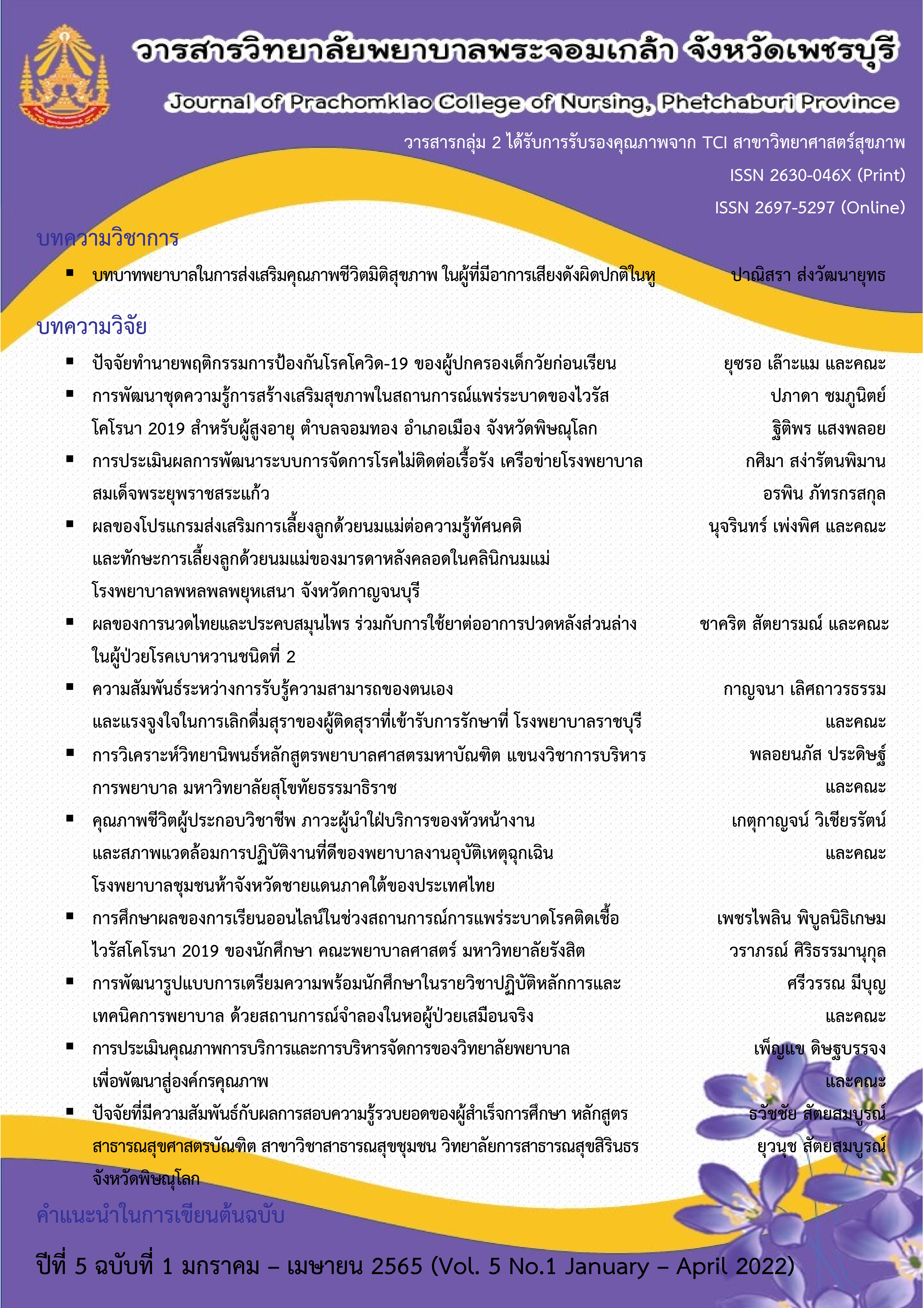บทบาทพยาบาลในการส่งเสริมคุณภาพชีวิตมิติสุขภาพ ในผู้ที่มีอาการเสียงดังผิดปกติในหู
Main Article Content
บทคัดย่อ
อาการเสียงรบกวนในหูเป็นหนึ่งในอาการทางหูที่พบได้บ่อย มักพบในผู้ป่วยที่สูญเสียการได้ยิน และยังไม่มีวิธีการรักษาให้หายขาด ถึงแม้ว่าภาวะเสียงรบกวนในหูจะไม่ก่อให้เกิดอันตรายถึงชีวิตแต่ส่งผลต่อการสูญเสียการได้ยิน ก่อให้เกิดความรำคาญ ซึมเศร้า ขาดความมั่นใจในการร่วมงานกับผู้อื่น และทำให้คุณภาพชีวิตด้านสุขภาพลดลง
บทความนี้ ได้อธิบายถึงกลไกทางพยาธิสภาพของผู้ที่มีอาการเสียงดังผิดปกติในหู การประเมินสภาพผู้ที่มีอาการเสียงดังผิดปกติในหู การรักษาผู้ที่มีอาการเสียงดังผิดปกติในหู คุณภาพชีวิตมิติสุขภาพในผู้ที่มีอาการเสียงดังผิดปกติในหู และบทบาทพยาบาลในการส่งเสริมคุณภาพชีวิตในผู้ที่มีอาการเสียงดังผิดปกติในหู โดยเฉพาะการพยาบาลผู้ที่มีอาการเสียงดังผิดปกติในหู ได้แก่ การสูบบุหรี่ ลดการดื่มสุรา ลดการดื่มชากาแฟ ควรออกกำลังกายอย่างสม่ำเสมอ การนอนหลับพักผ่อนที่มีดีมีคุณภาพ มีการใช้ความคิดและพฤติกรรมบำบัด มีการปล่อยเสียงเพื่อทำให้ผู้ป่วยรู้สึกเคยชินกับเสียงรบกวนในหู ให้คำแนะนำเกี่ยวกับการดูแลเครื่องช่วยฟังอย่างถูกวิธี หลีกเลี่ยงการอยู่ในสถานที่มีเสียงดังตลอดเวลา รวมทั้ง การสนับสนุนทางสังคม เพื่อนำไปสู่การมีคุณภาพชีวิตมิติสุขภาพที่ดีต่อไป
Downloads
Article Details

อนุญาตภายใต้เงื่อนไข Creative Commons Attribution-NonCommercial-NoDerivatives 4.0 International License.
เนื้อหาและข้อมูลที่เผยแพร่ในวารสารวิทยาลัยพยาบาลพระจอมเกล้า จังหวัดเพชรบุรี ถือเป็นข้อคิดเห็นและความรับผิดชอบของผู้นิพนธ์บทความโดยตรง บทความ เนื้อหา ข้อมูล รูปภาพ ฯลฯ ที่ได้รับการเผยแพร่ในวารสารนี้ ถือเป็นลิขสิทธิ์ของวารสารฯ หากบุคคลหรือหน่วยงานใดต้องการนำทั้งหมดหรือส่วนหนึ่งส่วนใดไปเผยแพร่หรือเพื่อกระทำการใด ๆ จะต้องอ้างอิงวิทยาลัยพยาบาลพระจอมเกล้า จังหวัดเพชรบุรี ทุกครั้ง
เอกสารอ้างอิง
ธีรพร รัตนาอเนกชัย, และสุภาภรณ์ ศรีร่มโพธิ์ทอง. (2557). ตำราหู คอ จมูก สำหรับนักศึกษาแพทย์ และ แพทย์เวชปฏิบัติทั่วไป. คลังนานาวิทยา.
เสาวรส ภทรภักดิ์. (2557). โสตประสาทวิทยา. สำนักพิมพ์แห่งจุฬาลงกรณ์มหาวิทยาลัย.
ศณัฐธร เชาวน์ศิลป. (2564). การรักษาภาวะเสียงรบกวนในหูด้วยวิธีการบำบัดด้วยเสียงผ่านอุปกรณ์กำเนิดเสียง เครื่องช่วยฟัง และประสาทหูเทียม. วารสารการแพทย์และวิทยาศาสตร์สุขภาพ, 28(3), 160-174.
Beukes, E. D., Andersson, G., Fagelson, M.A., & Manchaiah, V. (2021). Dismantling internet-based cognitive behavioral therapy for tinnitus. The contribution of applied relaxation: A randomized controlled trial. Internet Interventions, 25, Article 100402. https://doi.org/10.1016/j.invent.2021.100402
Boecking, B., Biehl, R., Brueggemann, P., & Mazurek, B. (2021). Health-related quality of life, depressive symptoms, anxiety, and somatization symptoms in male and female patients with chronic tinnitus. Journal of Clinical Medicine, 10(13), Article 2788. https://doi.org/10.3390/jcm10132798
Biehl, R., Boecking, B., Brueggemann, P., Grosse, R., & Mazurek, B. (2020). Personality traits, perceived stress, and tinnitus-related distress in patients with chronic tinnitus: support for a vulnerability-stress model. Frontiers in Psychology, Article 3093. https://doi.org/10.3389/fpsyg.2019.03093
Beukes, E. W., Vlaescu, G., Manchaia, V., Baguley, D. M., Allen, P. M., Kaldo, V., & Andersson, G. (2016). Development and technical functionality of an internet-based intervention for tinnitus in the UK. Internet Interventions, 6, 6-15.
Greenwell, K., Featherstone, D., & Hoare, J. D. (2015). The application of intervention coding methodology to describe the tinnitus E-programme, an internet-delivered self-help intervention for tinnitus. American Journal of Audiology, 24, 311-315.
Han, T. S., Jeong, J. E., Park, S. N., & Kim, J. J. (2019). Gender differences affecting psychiatric distress and tinnitus severity. Clinical Psychopharmacology and Neuroscience, 17(1), 113-120. https://doi.org/10.9758/cpn.2019.17.1.113
Heinecke, K., Weise, C., & Rief, W. (2009). Psychophysiological effects of biofeedback treatment in tinnitus sufferers. British Journal of Clinical Psychology, 48, 223-239.
Henry, A. J. (2017). Pathophysiology of Tinnitus and evidence-based options for tinnitus management. American Speech-Language-Hearing Association, 2(4), 157-168.
Hesser, H., Weise, C., Westin, V. Z., & Andersson, G. (2011). A systematic review and meta-analysis of randomized controlled trials of cognitive–behavioral therapy for tinnitus distress. Clinical Psychology Review, 31, 545–553.
Hoare, D. J., Searchfield, G. D., El Refaie, A., & Henry, J. A. (2014). Sound therapy for tinnitus management: practicable options. Journal of the American Academy of Audiology, 25(1), 62-75.
Loprinzi, P. D., Lee, H., Gilham, B., & Cardinal, B. J. (2013). Association between accelerometer-assessed physical activity and tinnitus, NHANES 2005–2006. Research Quarterly for Exercise and Sport, 84(2), 177-185.
Mahmoudian Sani, M. R., Hashemzadeh-Chaleshtori, M., Asadi-Samani, M., & Yang, Q. (2017). Ginkgo biloba in the treatment of tinnitus: An updated literature review. International Tinnitus Journal, 21(1), 58-62.
McCormack, A., Edmondson-Jones, M., Mellor, D., Dawes, P., Munro, J. K., Moore, R. D. & Fortnum, H. (2014). Association of dietary factors with presence and severity of tinnitus in a middle-aged UK population. PLoS One, 9(12), Article 114711. https://doi: 10.1371 /journal, pone.0114711.
McCormack, A., Edmondson-Jones, M., Somerset, S., & Hall, D. (2016). A systematic review of the reporting of tinnitus prevalence and severity. Hearing Research, 337, 70-79.
Murphy, E. C. (2012). The effect of social support on quality of life for tinnitus sufferers. International Tinnitus Journal. 17(2), 173-179.
Pattyn, T., Van Den Eede, F., Vanneste, S., Cassiers, L., Veltman, D. J., Van De Heyning, P., & Sabbe, B. C. G. (2016). Tinnitus and anxiety disorders: A review. Hearing Research, 333, 255-265. https://doi.org/10.1016/j.heares.2015.08.014
Salazar, J. W., Meisel, K., Smith, E. R., Quiggle, A., McCoy, D. B., & Amans, M. R. (2019). Depression in patients with tinnitus: A systematic review. Otolaryngology–Head and Neck Surgery, 161(1), 28-35.
Shubert, M. A. N., Rosmalen, G. M. J., Diijk, V. P., & Pyott, J. S. (2021). A retrospective cross-sectional study on tinnitus prevalence and disease associations in the Dutch population-based cohort Lifelines. Hearing Research, 411. Article 108355. https://doi.org/10.1016/j.heares.2021.108355
Shore, S. E., Roberts, L. E., & Langguth, B. (2016). Maladaptive plasticity in tinnitus-triggers, mechanisms and treatment. Nature Reviews Neuroscience, 12(3), 150-160.
Wagenaar, O. V., Schubert, N. M., van Rood, Y. R., & Rosmalen, J. G. (2022). Factors associated with Self Rated Health in persons with tinnitus from the general population. Journal of Psychosomatic Research, 153, Article 110693. https://doi.org/10.1016/j.jpsychores.2021.110693
The WHOQOL Group. (1995). The world health organization quality of life assessment (WHOQOL): Position paper from the world health organization. Social Science and Medicine, 41, 1403-1409.
Zeman, F., Koller, M., Langguth, B., Landgrebe, M., & Tinnitus Research Initiative database study group. (2014). Which tinnitus-related aspects are relevant for quality of life and depression: Results from a large international multicentre sample. Health and Quality of Life Outcomes, 12, Article 7. http://www.hqlo.com/content/12/1/7


